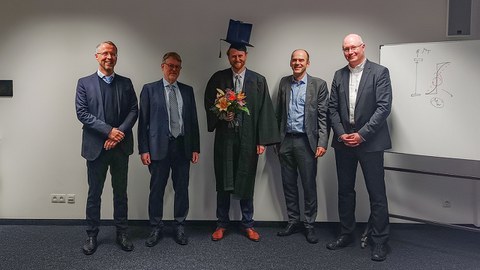Dec 19, 2023
Promotion Fabian Johannes Klein

Fabian Klein und die anwesende Promotionskommission
Am 15.12.2023 verteidigte Herr Fabian Johannes Klein, M.Sc. erfolgreich seine wissenschaftliche Arbeit im Rahmen des Promotionsverfahrens mit dem Thema „Modeling the Torsional Behaviour of Segmented Concrete Towers based on Warping Theory“. Neben dem Vorsitzenden der Promotionskommission, Prof. Dr. Michael Kaliske, (TU Dresden), waren als Gutachter Herr Prof. Dr. Steffen Marx (TU Dresden) und Prof. Dr. Stefan Löhnert (TU Dresden). Via Webkonferenz zugeschaltet war Prof. Dr. Aurelio Muttoni (EPFL). Als weiteres Mitglied der Promotionskomission war Prof. Dr. Richard Stroetmann (TU Dresden) anwesend.
Abstract:
The development of renewable energies and the desired independence from fossil energy sources are essential for security of supply. Wind energy turbines already account for the largest share of electricity generation in Germany. As part of modular precast concepts for wind turbine towers, vertical joints now divide the segments into even smaller components. This significantly reduces transport costs and installation time. The load-bearing behaviour of these segmented concrete towers is very complex due to the horizontal and vertical joints and the resulting restrained cross-sectional deformations. In the case of thin-walled half-shell segments now used in modern wind turbine towers, cross-sectional distortion and warping can significantly reduce the load-bearing capacity. Even under pure torsional loading, there is a decrease in the horizontal joint load capacity compared to conventional thin-walled circular rings. However, there are currently no design approaches for this new construction, as the structural behaviour is neither fully understood nor reliably modeled.
This cumulative dissertation deals with the modeling of the torsional behaviour of segmented concrete towers for wind turbines based on the warping theory of thin-walled bars. Transferring the complex mechanical relationships into an understandable and comprehensible bar model allows differentiated evaluation approaches. In the case of segmented concrete towers, this leads to the long-term realization of even more innovative, higher and safer tower concepts. With this calculation approach, the practical engineer always remains in control of his or her own actions. Accordingly, the results can be used as a basis for evaluation without much need for interpretation, e.g. to assess the effect of restrained sectional warping on the distribution of normal stresses. The successive derivation of an engineering approach is presented using mechanical modeling concepts and non-linear numerical investigations as well as further (experimental) investigations. This provides the basis for future validation with carefully conducted tests on actual concrete segments.
The presentation of the overall results of this dissertation shows that the successive extension of the model approach leads to a more precise and differentiated isolation of the influencing variables. This improves the realistic representation of the torsional behaviour of assembled half-shells based on the warping theory of thin-walled bars, taking the application limits into account. However, the simplicity and applicability of the engineering model are not compromised by the continuous development. The analytically proven and numerically validated dependence on the slenderness ratio of the segments results in a better understanding of the load transfer in the modular precast structure. A much simplified internal force calculation can be used as the basis for the reinforced concrete design by applying the analogy to the tension rod under bending stress. The division of the load components provides a better understanding of the force flow of the modular structure. Accordingly, the combination of the tension rod analogy, the load redistribution principle and the modified deformation approach, taking the adjacent segments into account, allow the user to isolate and evaluate the influencing parameters of the torsional behaviour with little effort. Finally, in addition to model approaches and detailed numerical simulations, accompanying experimental investigations are required, and this dissertation provides the basis for a coherent and well-conceived experimental program.
Wir gratulieren Herrn Klein herzlich zum abgeschlossenen Promotionsverfahren und wünschen ihm alles erdenklich Gute und viel Erfolg für seinen weiteren Weg.
